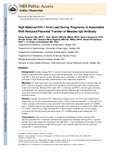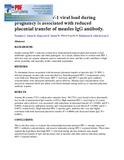| dc.contributor.author | Farquhar, C | |
| dc.contributor.author | Nduati, RW | |
| dc.contributor.author | Haigwood, N | |
| dc.contributor.author | Sutton, W | |
| dc.contributor.author | Mbori-Ngacha, DA | |
| dc.contributor.author | Richardson, B | |
| dc.contributor.author | John-Stewart, G | |
| dc.date.accessioned | 2013-06-10T09:48:19Z | |
| dc.date.available | 2013-06-10T09:48:19Z | |
| dc.date.issued | 2005-12 | |
| dc.identifier.citation | J Acquir Immune Defic Syndr. 2005 Dec 1;40(4):494-7. | en |
| dc.identifier.uri | http://www.ncbi.nlm.nih.gov/pubmed/16280707 | |
| dc.identifier.uri | http://erepository.uonbi.ac.ke:8080/xmlui/handle/123456789/30623 | |
| dc.description.abstract | BACKGROUND:
Studies among HIV-1-infected women have demonstrated reduced placental transfer of IgG antibodies against measles and other pathogens. As a result, infants born to women with HIV-1 infection may not acquire adequate passive immunity in utero and this could contribute to high infant morbidity and mortality in this vulnerable population.
METHODS:
To determine factors associated with decreased placental transfer of measles IgG, 55 HIV-1-infected pregnant women who were enrolled in a Nairobi perinatal HIV-1 transmission study were followed. Maternal CD4 count, HIV-1 viral load, and HIV-1-specific gp41 antibody concentrations were measured antenatally and at delivery. Measles IgG concentrations were assayed in maternal blood and infant cord blood obtained during delivery to calculate placental antibody transfer.
RESULTS:
Among 40 women (73%) with positive measles titers, 30 (75%) were found to have abnormally low levels of maternofetal IgG transfer (<95%). High maternal HIV-1 viral load at 32 weeks' gestation and at delivery was associated with reductions in placental transfer (P < 0.0001 and P = 0.0056, respectively) and infant measles IgG concentrations in cord blood (P < 0.0001 and P = 0.0073, respectively). High maternal HIV-1-specific gp41 antibody titer was also highly correlated with both decreased placental transfer (P = 0.0080) and decreased infant IgG (P < 0.0001).
CONCLUSIONS:
This is the first study to evaluate the relationship between maternal HIV-1 viremia, maternal HIV-1 antibody concentrations, and passive immunity among HIV-1-exposed infants. These data support the hypothesis that high HIV-1 viral load during the last trimester may impair maternofetal transfer of IgG and increases risk of measles and other serious infections among HIV-1-exposed infants. | en |
| dc.language.iso | en | en |
| dc.publisher | University of Nairobi. | en |
| dc.title | High maternal HIV-1 viral load during pregnancy is associated with reduced placental transfer of measles IgG antibody. | en |
| dc.type | Article | en |
| local.publisher | Department of Medicine, University of Washington, Seattle | en |
| local.publisher | Department of Paediatrics and Child Health, Univeristy of Nairobi, Kenya | en |


